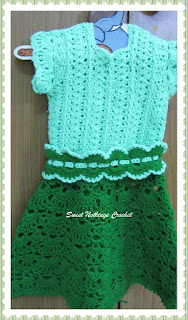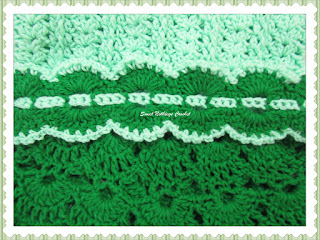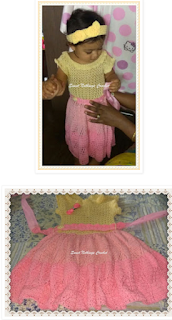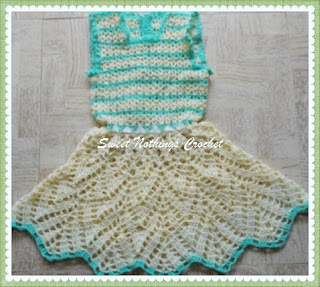AMAIRA's SHELLED DRESS WITH A MATCHING BELT
I love it when I get a request to make a new
design and all I’m given is a colour – and then told “go ahead and make
something new and beautiful”. Here’s
what’s new and beautiful with this creation that I’m making for a 18 – 24m baby
girl. Thank you for joining me on this
new journey of creation.
Thank you for joining me.
In case you have just joined me, know that you can access all of my earlier creations by checking under ‘categories’ on the right hand side of this blog under “Labels”. Then, for your convenience, follow me here or on Facebook, You Tube, Pinterest, Twitter or Instagram.
Check out all my social media handles at the bottom of this blog
Oh, and may I add that the fastest way to find any of my blogs is via Pinterest.
All my blogs can be printed. Find the printer friendly (green) link on the right side of this blog. You can also hit Control P (or Command P for Mac) on your keyboard, and the blog will go directly to the connected printer.
Remember that you only print if absolutely essential. Save paper – Save Our Earth.
Do remember to add my blog URL when you make and show off your creation.
Just copy the link on the search bar above - that's the blog URL.
To purchase this or similar yarn online, click the highlighted links below to buy your yarns online via Amazon. While you will still pay the same, I may get paid by Amazon as well.
This is a free blog - so do pay it forward for me. Cheers.
Thanks for joining me once again as we work on and discover this new pattern together.
General yarn info : The yarn used today is not specific to this pattern.
You can use any yarn with a suitable hook to make this project to any size.
International yarns : Among the international yarns I have used in this thickness, I’d suggest Aunt Lydia Cotton 10, Aunt Lydia Bamboo-Viscose 10, DMC Petra, Sullivans knitting cotton (Australia), Milford Soft, Hilaza Rustica Eclat , Alize cotton yarn and Alize bamboo yarn , Lily Sugar n' Cream cotton yarn, Caron Simply Soft , Bernat Softee chunky.
Size made : For a 18 - 24 month old
You can make this to any size. Size only given for yarn estimation.
Difficulty level : Intermediate Skill level
Stitches used :
Double Crochet : dc : yo, insert hk into st ; yo (3 lps on hk);
[yo, draw through 2 lps] twice. One dc made.
Chainless start for Double Crochet : I dislike the ch-2 / ch – 3 start, and this is what I do to start my row of dc.
dc 3-tog : Double crochet 3-tog : [yo, insert hk in st or ch-sp, yo and pull up a lp ; yo and draw through 2 lps] 3 times (4 lps on hk) ; yo, draw through all lps on hk. One dc 3-tog made.
Here is a sizing chart for general neck sizing
Abbreviations used : (Using U.S terminology)
lp(s) : Loop(s) sc : Single crochet
dc : Double crochet sp : Space
sl-st : Slip stitch st(s) : Stitch(es)
hk : Hook
yo : Yarn Over ch : Chain
fsc : Foundation Single Crochet
dc 3-tog : Double crochet 3-together
Instructions
Please note that I start all my rows with a ch 1, turning chain for ease.
Please check the top of this blog for easy video tutorials on all stitches used in today's pattern.
Please read through all my notes before you pick up your hook, so you know just where we're heading in our pattern.
In my patterns I work with the principle of stitch count and body measurement.
This means that you need to work the stitch count in pattern, till you get the measurement (length and/or width) that you need for your project.
And as we’re making requests, may I request you to link my blog when you make your project. I feel horrid saying this, but there are many who have used the patterns freely given here, and not given any credit to the blog that has given them this pattern. Come on guys.. it ain’t that much work to give credit and link the blog now, is it?
It’s worse when someone says “taken this from …(where ever they’ve taken the pattern from.. not just my blog I mean)” and not taking the trouble of giving the proper link(s).
You got a free pattern .. Pay It Forward ! Share away and add my blog link
I do not claim this to be my pattern , but here are my pattern notes as I make my own original project
So before we set off on our new creative
journey, let’s take a quick look at what we’re creating here today.
Now there is a link for a set of sizing /
measurement charts depending on age of child and I’d suggest we use that as a
reference. I always suggest that if
you’re making this specifically for someone you know, try and get a well-fitted
dress / outfit of that child.
Part I : Yoke
(Work 2 pieces)
For the yoke, we will work two pieces, one each
for the front and back.
For the back the pattern is exactly the same, but you will need to
divide for the button placket.
For this, all you will do is mark the centre of
the back, place a marker, and then work back and forth from the armhole
to this marker for the part of the yoke that you’ve decided to place buttons
on. Simple enough, right – so let’s
start.
Start Row 1 : with fsc in multiples of 7 + 3 for the
across chest/waist of the child you are making this for. Turn.
Row 2 : dc in the 1st 3 fsc ;
*sk next fsc, 2 dc each in the next 2 dc ;
sk
next fsc, dc in the next 3 fsc* ;
rep *to* till end. Turn.
In the following row, we’ll work our post
stitches.
Front Post Double Crochet : fpdc : Post stitches are stitches worked around the post of a stitch of the row below.
How to work the fpdc : yo, hk into sp between posts of st from row below – going from back of stitch, around st and into the front of the st ; yo, pull yarn through the sps (3 lps on hk), (yo & pull through 2 lps) twice. One fpdc complete
Back Post Double Crochet : bpdc : Post stitches are stitches worked around the post of a stitch of the row below. Here is an easy video tutorial for the bpdc at https://youtu.be/l9Nt3miOs3s
In the following row, we will also work in a
Shell stitch (Shell St).
Our Shell
stitch is (2 dc ; ch 1, 2 dc) all in the same st or ch-1 sp.
Row 3 : dc in the 1st dc ;
bpdc in the
next dc ; dc in the next dc ;
*sk next 2 dc, Shell stitch in the sp between
the dc’s ;
sk next 2 dc (dc in the next dc ; bpdc in the next dc ; dc in the
next dc)* ;
rep *to* till end. Turn.
In the following row onwards, we will work in a
Shell stitch in the ch-1 sp of the earlier Shell St. So instructions will just
read “Shell st in Shell st”, and that automatically means in that ch-1 sp.
We will be alternating with back post and front
post stitches such that you get a neat continuous line in your pattern. So in each bpdc of the earlier row, you will
work a fpdc ; and in each fpdc of the earlier row, you will work in a bpdc.
However, when I write the instructions, I will
say work a fpdc in a dc, or a bpdc in a dc.
Row 4 : dc in the 1st dc ;
fpdc in the
next dc ; dc in the next dc ;
*Shell St in the next Shell St ;
sk next 2 dc
(dc in the next dc ; fpdc in the next dc ; dc in the next dc)* ;
rep *to* till end. Turn.
Row 5 : dc in the 1st dc ;
bpdc in the
next dc ; dc in the next dc ;
* Shell St in the next Shell St ;
sk next 2 dc
(dc in the next dc ; bpdc in the next dc ; dc in the next dc)* ;
rep *to* till end. Turn.
You have,
I am sure, figured out the pattern repeat.
Rep Rows 4
& 5 till your yoke / bodice is at the armhole level.
As we are
all working different sizes for the dress, I will write a generalised set of
instructions for armhole and neckline decreases. It does not matter whether you are working a
front or a back post, as long as you remember that you need to alternate them,
and keep the pattern going. So for
convenience, I will just write, work a “post stitch” and you work it according
to the row you’re working on.
Part 2 : Armhole decrease ideas
sl-st in the 1st 5 dc (i.e 1st
3 dc plus 2 dc of the 1st Shell stitch) ;
2 dc in the 1st
ch-1 sp ;
*(dc in the next dc ; work a post stitch in the next dc ; dc in the
next dc) ;
Shell St in the next Shell St* ;
rep *to* till the last ch-1 sp ;
2
dc in that last ch-1 sp. Turn.
Next row : 2 dc in the 1st 2 dc ;
*(dc in the
next dc ; work a post stitch in the next dc ; dc in the next dc) ;
Shell St in
the next Shell St* ;
rep *to* till the 2 dc ;
dc in the last 2 dc. Turn.
Rep this row till you reach the neckline.
Part 3 : Neckline decrease ideas
Fold your work in half and decide the two side
extremes of your neckline.
Place markers
at those points.
Work in pattern from one armhole to the 1st
marker and then work back to the armhole.
Continue in pattern till you reach the shoulder level. Fasten off and weave in ends.
You will then re-attach your yarn at the 2nd
marker, and work from the 2nd marker till the armhole, back and
forth, till you reach the shoulder level again.
Fasten off and weave in ends.
You have completed the front of your work.
Repeat all instructions for the back.
Remember though, that as you’re working in a button placket, you will
split your work near the back neck, to accommodate the button placket.
Complete the back, and I suggest you join the
shoulders and sides (under armhole) portions, so that we can work in rounds for
the skirt portion of our dress.
Part 4 : Skirt part of dress
For this part of the project, we will be working
in rounds.
We will go back to that 1st fsc round and work off that
round
Our stitch count is in multiples of 7
so
you could either calculate /add/subtract to get multiples of 7 (we started with
7 + 3 for yoke). As this is the skirt portion, I'd say add, so that you can get a better flare to the dress.
Round 1 : sc in the 1st fsc ;
*ch 5, sk next 2 fsc, sc in the next fsc ;
ch 5,
sk next 3 fsc, sc in the next fsc* ;
rep *to* all around and join with a sl-st to the
1st sc.
Ensure you have an
even number of ch-5 sps
Round 2 : sl-st in the 1st ch-5 sp , sc in
the same ch-5 sp ;
*8 dc in the next ch-5 sp ; sc in the next ch-5
sp* ;
rep *to* all around and join with a sl-st to the
1st sc.
Round 3 : sl-st in the 1st dc ; dc in the next
dc ;
*(ch 1, dc in the next dc) ;
rep (to) 4 times ;
sk next 2 dc, dc in the next dc* ;
rep *to* all around and join with a sl-st to the
1st dc.
Round 4 : sl-st in the 1st ch-1 sp ; sc in
the same ch-1 sp ;
*(ch 3, sc in the next ch-1 sp);
rep (to) 3
times ;
sk next 2 dc, sc in the next ch-1 sp* ;
rep *to* all around and join
with a sl-st to the 1st dc.
Round 5 : sk the 1st ch-3 sp , sl-st and sc in
the next ch-3 sp ;
*ch 5 ; sc in the next ch-3 sp ;
ch 5, sk next two
ch-3 sps, sc in the next ch-3 sp* ;
rep *to* all around and join with a sl-st
to the 1st sc.
Round 6 : sl-st in the 1st ch-5 sp , 9 dc in
the same ch-5 sp ;
sc in the next ch-5 sp
*9 dc in the next ch-5 sp ; sc in the next ch-5
sp* ;
rep *to* all around and join with a sl-st to the
1st sc.
Round 7 : sl-st in the 1st dc ; dc in the next
dc ;
*(ch 1, dc in the next dc) ;
rep (to) 5 times ;
sk next 2 dc, dc in the next dc* ;
rep *to* all around and join with a sl-st to the
1st dc.
Round 8 : sl-st in the 1st ch-1 sp ; sc in
the same ch-1 sp ;
*(ch 3, sc in the next ch-1 sp);
rep (to) 4
times ;
ch 1, sk next 2 dc, sc in the next ch-1 sp* ;
rep *to* all around ;
ch 1, and join with a sl-st to the 1st
dc.
Round 9 : sk the 1st ch-3 sp , sl-st and sc
in the next ch-3 sp ;
*ch 5 ; sk next ch-3 sp, sc in the next ch-3 sp
;
ch 3, sk next ch-3 sp, dc in the next ch-1 sp ;
ch 3, sk next ch-3 sp, sc in
the next ch-3 sp* ;
rep *to* all around ;
ch 3, dc in the last ch-1 sp ;
ch 3, and join
with a sl-st to the 1st sc.
Round 10 : sl-st in the 1st ch-5 sp , 9 dc in
the same ch-5 sp ;
*sc in the next ch-3 sp ;
ch 5, sk next dc, sc
in the next ch-3 sp ; 9 dc in the next ch-5 sp* ;
rep *to* all around and join with a sl-st to the
1st sc.
Round 11 : sl-st in the 1st dc ; dc in the next
dc ;
*(ch 1, dc in the next dc) ;
rep (to) 5 times ;
sk next dc, [dc ; ch 1, dc] in the next ch-5 sp ;
sk next dc, dc in the next dc*
;
rep *to* all around ;
rep [to] once and join
with a sl-st to the 1st dc.
Round 12 : sl-st in the 1st ch-1 sp ; sc in
the same ch-1 sp ;
*(ch 3, sc in the next ch-1 sp);
rep (to) 4 times
;
ch 3, sk next 4 dc & ch-1 sp, sc in the next ch-1 sp* ;
rep *to* all
around ;
ch 3, and join with a sl-st to the 1st
dc.
Round 13 : sk the 1st ch-3 sp , sl-st and sc
in the next ch-3 sp ;
*ch 5 ; sk next ch-3 sp, sc in the next ch-3 sp
;
ch 4 , sk next ch-3 sp, (dc ; ch 1, dc) all in the next ch-3 sp ;
ch 4, sk
next ch-3 sp, sc in the next ch-3 sp * ;
rep *to* all around ;
ch 3, dc in the last ch-1 sp ;
ch 3, and join
with a sl-st to the 1st sc.
Round 14 : sl-st in the 1st ch-5 sp , 9 dc in
the same ch-5 sp ;
*sc in the next ch-4 sp ;
(hdc ; 2 dc ; hdc) all
in the next ch-1 sp ;
sc in the next ch-4 sp ; 9 dc in the next ch-5 sp* ;
rep *to* all ;
rep (to) once and around and join
with a sl-st to the 1st sc.
Round 15 : sl-st in the 1st dc ; dc in the next
dc ;
*(ch 1, dc in the next dc) ;
rep (to) 5 times ;
[sk
next dc & hdc, dc in the next dc ; ch 2, dc in the next dc] ;
sk next hdc
& dc, dc in the next dc* ;
rep *to* all around ;
rep [to] once and join
with a sl-st to the 1st dc.
Round 16 : sl-st in the 1st ch-1 sp ; sc in
the same ch-1 sp ;
*(ch 3, sc in the next ch-1 sp) ;
rep (to) 4
times ;
[ch 4, sc in the next ch-2 sp ; ch 4, sc in the next ch-1 sp]* ;
rep
*to* all around ;
ch 3, rep [to] once and join with a sl-st to the
1st dc.
Round 17 : sk the 1st ch-3 sp , sl-st and sc
in the next ch-3 sp ;
*ch 5 ; sk next ch-3 sp, sc in the next ch-3 sp
;
[ch 5 , sk next ch-3 sp, dc in the next ch-4 sp ;
ch 2, dc in the next ch-4
sp] ;
ch 5, sk next ch-3 sp, sc in the next ch-3 sp* ;
rep *to* all around ;
rep [to] once and join with a sl-st to the 1st
dc.
Round 18 : sl-st in the 1st ch-5 sp , 9 dc in
the same ch-5 sp ;
*sc in the next ch-5 sp ;
(hdc ; 3 dc ; hdc) all
in the next ch-2 sp ; sc in the next ch-5 sp ;
9 dc in the next ch-5 sp* ;
rep *to* all ;
rep (to) once and around and join
with a sl-st to the 1st sc.
Round 19 : sl-st in the 1st dc ; dc in the next
dc ;
*(ch 1, dc in the next dc) ;
rep (to) 5 times ;
{sk
next hdc, dc in the next dc ;
[ch 2, dc in the next dc] ;
rep [to] once} ;
sk
next hdc, dc in the next dc* ;
rep *to* all around ;
rep {to} once and join
with a sl-st to the 1st dc.
Round 20 : sl-st in the 1st ch-1 sp ; sc in
the same ch-1 sp ;
*(ch 3, sc in the next ch-1 sp) ;
rep (to) 4
times ;
[sc in the next ch-2 sp ; ch 3, sc in the next ch-2 sp] ;
sc in the
next ch-1 sp* ;
rep *to* all around ;
ch 3, rep [to] once and join with a sl-st to the
1st dc.
Round 21 : sk the 1st ch-3 sp , sl-st and sc
in the next ch-3 sp ;
*ch 5 ; sk next ch-3 sp, sc in the next ch-3 sp
;
[ch 5 , sk next ch-3 sp, dc in the next ch-3 sp ;
ch 3, dc in the same
ch-3 sp] ;
ch 5, sk next ch-3 sp, sc in the next ch-3 sp*;
rep *to* all around ;
rep [to] once and join with a sl-st to the 1st
dc.
Round 22 : sl-st in the 1st ch-5 sp , 9 dc in
the same ch-5 sp ;
*6 dc in the next ch-3 sp ; 9 dc in the next
ch-5 sp* ;
rep *to* all around and join with a sl-st to the
1st sc.
Round 23 : sl-st in the 1st dc ; dc in the next
dc ;
*(ch 1, dc in the next dc) ;
rep (to) 5 times ;
{sk next 2 dc, dc in the next dc ;
rep (to) 2 times}* ;
rep *to* all around and
join with a sl-st to the 1st st.
This is as far as I am working as I have the
length needed.
IF you need more length,
then check out the chart and work your repeats.
Basically, as you may have noticed, we’re working a similar pattern for
the past several rounds. So you could work pattern rounds 16 – 19 or 20 – 23 if
you’d like.. or see what the chart has from Round 24 on.
As the following round is my last one, I am
going to work in a decorative picot. I
am going to use the ch-3 picot, which is (ch 3, sl-st in the 3rd ch
from hk).
Check out “how to work a
picot” in the stitches used information given above.
How to work a picot stitch : Traditionally for a ch-3 picot, you work (ch 3, sl-st in 3rd ch from hook). For a ch-5 picot, you will do (ch 5, sl-st in 5th ch from hook).
In the next round, we will work our decorative
picot in the ch-sps all around.
Round 24 : sl-st in the 1st ch-1 sp ;
sc +
picot in the same ch-1 sp ;
(sc + picot in the next ch-1 sp) in the next
ch-1 sp
and in each ch-1 sp all around.
Join with a sl-st to the 1st dc.
Fasten off and weave in ends.
Part 5 : Sleeves
For this part of the project, we will be, once
again, working in rounds.
Our pattern repeat stitch count is 6 ; just
so we can get it neat and even.
Attach
your yarn at the armhole.
Round 1 : sc all around your armhole opening evenly,
and in multiples of 7.
Join with a sl-st
to the 1st sc.
Round 1 : sc in the 1st fsc ;
*ch 3, sk next 2 sc, sc in the next sc ;
ch 3,
sk next 3 sc, sc in the next sc* ;
rep *to* all around and join with a sl-st to the
1st sc.
Ensure you have an
even number of ch-5 sps
Round 2 : sl-st into the 1st ch-3 sp , 7 dc
in the same ch-4 sp ;
*sc in the next ch-3 sp ; 7 dc in the next ch-3
sp* ;
rep *to* all around and join with a sl-st to the
1st dc.
Round 3 : sl-st in the 1st dc ; dc in the next
dc ;
*(ch 1, dc in the next dc) ;
rep (to) 3 times ;
sk next 2 dc, dc in the next dc* ;
rep *to* all around and join with a sl-st to the
1st dc.
Round 4 : sl-st in the 1st ch-1 sp ; sc in
the same ch-1 sp ;
*(ch 3, sc in the next ch-1 sp) ;
rep (to) 2
times ; sc in the next ch-1 sp* ;
rep *to* all around and join with a sl-st to
the 1st dc.
Fasten off and weave in ends.
Repeat for the second armhole as well.
Part 6 : Neckline finish
I quite like the wavy scallop-like edge of the
neckline, so I have just worked an sc in each st all around (as evenly as you
can where along the vertical part of the neck) and ensured that the back
placket is neat and finished as well. If
you are working in button holes, here is your chance to work in the holes in a
separate button placket. Fasten off and
weave in ends.
And though there are quite a few elements to
this creation, I am sure you will agree that this is a job really well done.
Part 7 : Belt
In keeping with the pattern of the skirt
portion, I’ve designed this belt to match this dress perfectly.
Our stitch count is in multiples of 7 + 2
What I have done is only work the front portion
in this pattern, and attach satin lace for the back – but you can work it all
around if you so feel like it – as long as you get the stitch count right.
So what we will do here is work a fsc chain, and then work the pattern first on
one side, and then swing around and work the same pattern on the other side of
the same fsc chain.
Start with fsc in
multiples of 7 + 2
Row 1 : sc in the 1st fsc ;
*ch 3, sk next 2 fsc, sc in the next fsc ;
ch 3,
sk next 3 fsc, sc in the next fsc* ;
rep *to* till end. Turn
Ensure you have an
uneven number of ch-3 sps
Row 2 : sl-st in the 1st ch-3 sp , sc in
the same ch-3 sp ;
*8 dc in the next ch-3 sp ; sc in the next ch-3
sp* ;
rep *to* till end (ending with 8 dc in the last
ch-sp). Turn
Row 3 : sc in the 1st dc ;
(ch 2, sc in
the next dc) ;
rep (to) 6 times
*sk next 2 dc, sc in the next dc ;
rep (to) 6
times* ;
rep *to* till end.
Fasten off and weave in ends.
You have finished one side of your belt. You could well stop at this point as this
looks really lovely too. There is a
lovely line of holes, and you can thread in a satin ribbon through that and be
done with it.
If you decide to continue with the second side,
then you will re-attach your yarn at the other side (or rather under side) of
the fsc chain, and rep Rows 1 – 3 for this side as well.
Fasten off
and weave in ends. If you’ve worked half
a belt (i.e just for the front portion), then pass a satin ribbon through the
ready-made holes and stitch the scallops down (for firmness) and you have a
lovely belt ready to go.
Have a fun creative time.
Enjoyed this ?? I sure did.. come back right
here for more freebie patterns
If you're visiting me here for the first time, and have liked the experience, do add me to your mailing list (for your convenience) , and all my future free patterns will come straight to your mail box.
I’d appreciate if you could credit my blog (and link the original pattern link) when you make your own creation. Thanks.
Have a great day and see you soon.
Here are some of my other creations. Have fun with these free patterns too
and here are a few skirt patterns that you can use your belt for..
Here are some of my tops
Here are some of my bolero / jacket / vest creations. Have fun with these free patterns too
Here is a list of my earlier miscellaneous home use projects. Enjoy























































